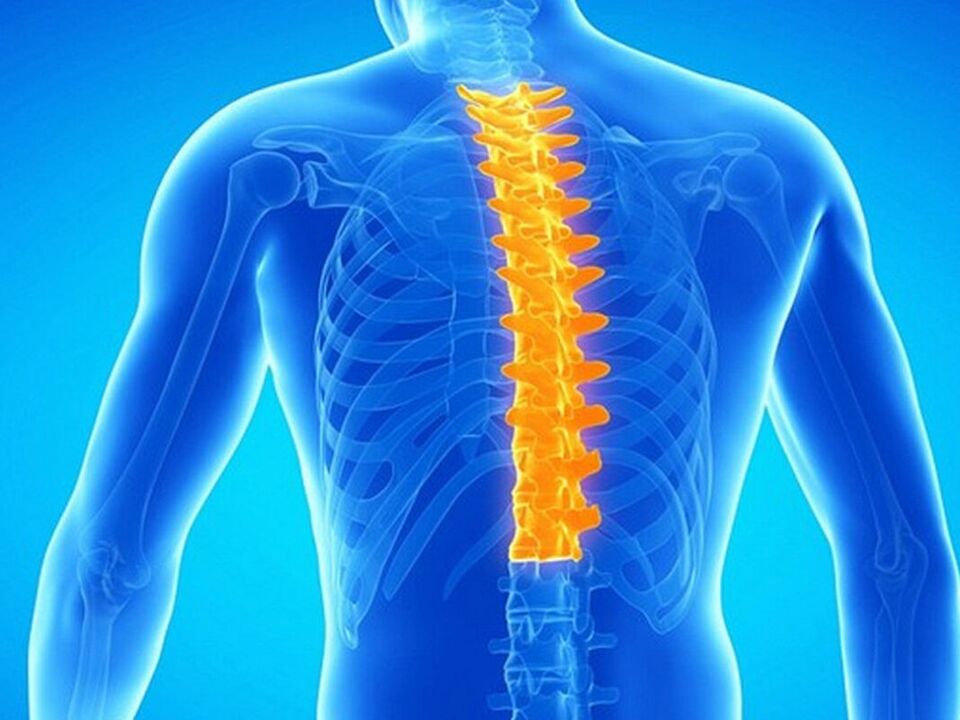
A sedentary lifestyle, injuries or excessive physical activity cause diseases of the musculoskeletal system. It is important to start treatment at an early stage of the process to avoid complications. To do this, you need to know about the causes and symptoms of the pathology.
Description of the disease, what is its danger
Osteochondrosis of the thoracic spine is a chronic disease in which dystrophic changes begin in the cartilage located in the intervertebral space. It is expressed by a decrease in the height of the pathological discs and compression of the intercostal nerve endings.
Thoracic osteochondrosis goes through several stages of development.
First, it is characterized by the drying of the intervertebral disc, a decrease in strength and flexibility, and the appearance of cracks. The pain is mild and disappears after a person rests for a while.
In the second stage, the disc height decreases, the cavity in the vertebra is filled with the nucleus pulposus, but does not extend beyond its limits. Muscles experience constant tension. A person complains of severe pain that subsides after rest.
The third stage is characterized by the protrusion of the nucleus pulposus from the edges, the crack reaches the edge of the vertebra. As a result, an intervertebral hernia is formed. The pain is constant.
In the fourth stage, excessive growth of connective tissue is detected, which puts pressure on the nearby vertebrae. Bone tissue growth begins to compensate for the reduced layer. More and more growths (osteophytes) appear.
Types and complications of thoracic osteochondrosis
According to the nature of the pain, there are two types of thoracic osteochondrosis:
- dorsago, characterized by a sharp sharp pain in the form of lumbago localized in the thoracic spine. The condition is accompanied by muscle tension, movement problems in the neck and thoracic region;
- dorsalgia, where the pain gradually increases. Inhalations and turns of the torso, as well as staying in one position for a long time, increase anxiety. The discomfort deepens at night and disappears when walking.
In the absence of adequate therapy, nerve endings are increasingly compressed. As a result, osteochondrosis of the thoracic spine can cause complications:
- kidney pathology;
- diseases of the digestive system;
- immobility;
- persistent pain;
- heart failure;
- intervertebral hernia;
- reduced ability to conceive;
- a disturbance in the work of the lungs caused by the growth of connective tissue.
Why does the pathology of the thoracic spine occur?
This part of the spine experiences moderate load and limited mobility. However, the pathology is very common. The disease can be provoked by one or a combination of reasons:
- injury and damage;
- excessive load on the department, including in childhood;
- age-related changes associated with a decrease in nutrition of the tissues of the discs between the vertebrae;
- diseases of the endocrinological profile, especially during menopause;
- age-related disturbance of calcium absorption;
- excess body weight;
- problems with blood vessels, atherosclerotic deposits in the vessels of the thoracic region;
- weak muscle corset.
How the pathology manifests itself
Symptoms of thoracic osteochondrosis are represented by pain and increased muscle tone. Pain can be both short-term and long-term pain with lumbago. Retraction can be felt in the front of the chest, under the ribs and in the shoulder. Pain intensifies with prolonged stay in one position.
A characteristic sign of pathology is sensitivity to palpation of the spinous processes of the thoracic vertebra.
Symptoms of osteochondrosis of the thoracic spine are similar to symptoms of other diseases and include:
- discomfort in the heart area, reminiscent of pain in angina pectoris;
- pain during breathing, shortness of breath, also manifests itself in pneumonia, tuberculosis, obstructive lung disease;
- pain in the epigastric region, under the ribs, similar to the symptoms of gastrointestinal diseases.
Methods of treatment of thoracic osteochondrosis
If you complain, you should contact a neurologist. Therapy includes medication, physical therapy, exercise therapy, and massage.
Medicines are prescribed by doctors:
- means to eliminate the focus of inflammation in the spine;
- drugs to reduce the risk of compressing muscle tone and sensitive roots of the spinal cord;
- neuroprotectors designed to help restore nerve fibers.
The choice and dosage is chosen by the doctor, who takes into account drug tolerance, comorbidities and the patient's weight.
It is important to follow the recommended treatment period to avoid relapses. You can buy prescribed medicines at a cheap price in the online store. Information about prices, drugs in stock, current promotions and discounts is available on the site 24/7.
Medicines can be ordered now, customers are offered the option of delivery and self-delivery.
Physiotherapy includes:
- diadynamic therapy, that is, electric current treatment to relax muscles and reduce pain;
- electrophoresis with painkillers;
- magnetic therapy to relieve discomfort and swelling.
Massage should be done carefully using friction methods. The area under the shoulder blades and between the ribs should be carefully treated. At least 10-15 sessions are needed for the effect to appear.
During physiotherapy exercises, the main focus is on exercises that strengthen the muscle corset, neck and lower back.
Topical ointments and gels with anti-inflammatory action, warming patches, needle applicator.






















